An Analysis of Quality and Safety in Health and Social Care Services
VerifiedAdded on 2022/12/28
|9
|2859
|42
Report
AI Summary
This report delves into the multifaceted aspects of quality within health and social care services. It begins by defining quality assurance and its critical role in providing optimal patient care, emphasizing the importance of feedback and continuous improvement. The report then explores two models for ensuring quality improvements, including Total Quality Management and the Plan-Do-Study-Act cycle, illustrating their practical application. Furthermore, it analyzes the Care Quality Commission's role in maintaining health and social care standards, alongside the use of benchmarks for performance evaluation and improvement. The report also evaluates various methods for gathering patient feedback, identifying key stakeholders in quality delivery, and assessing strategies to enhance service user safety, providing a comprehensive overview of quality management in healthcare settings.
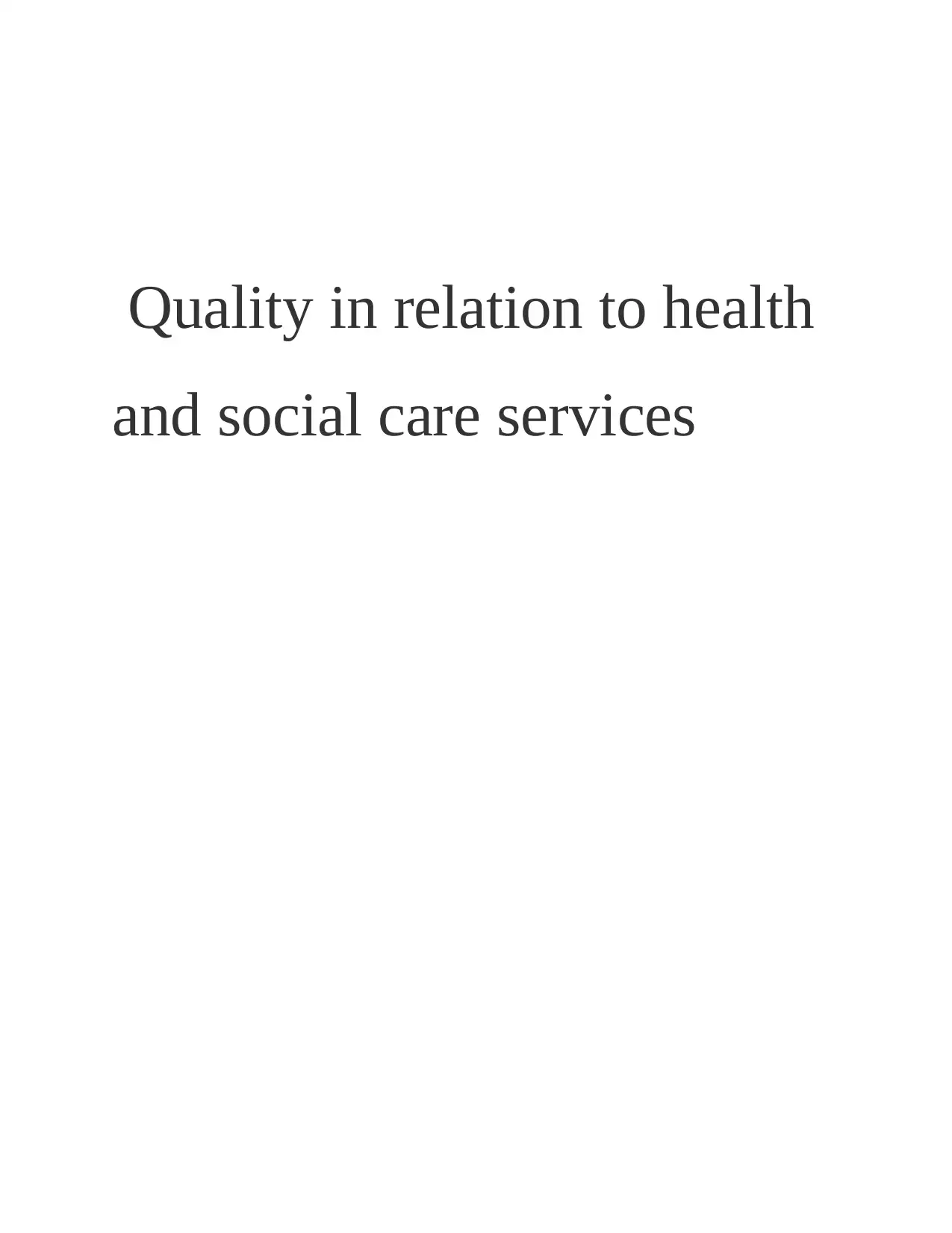
Quality in relation to health
and social care services
and social care services
Paraphrase This Document
Need a fresh take? Get an instant paraphrase of this document with our AI Paraphraser
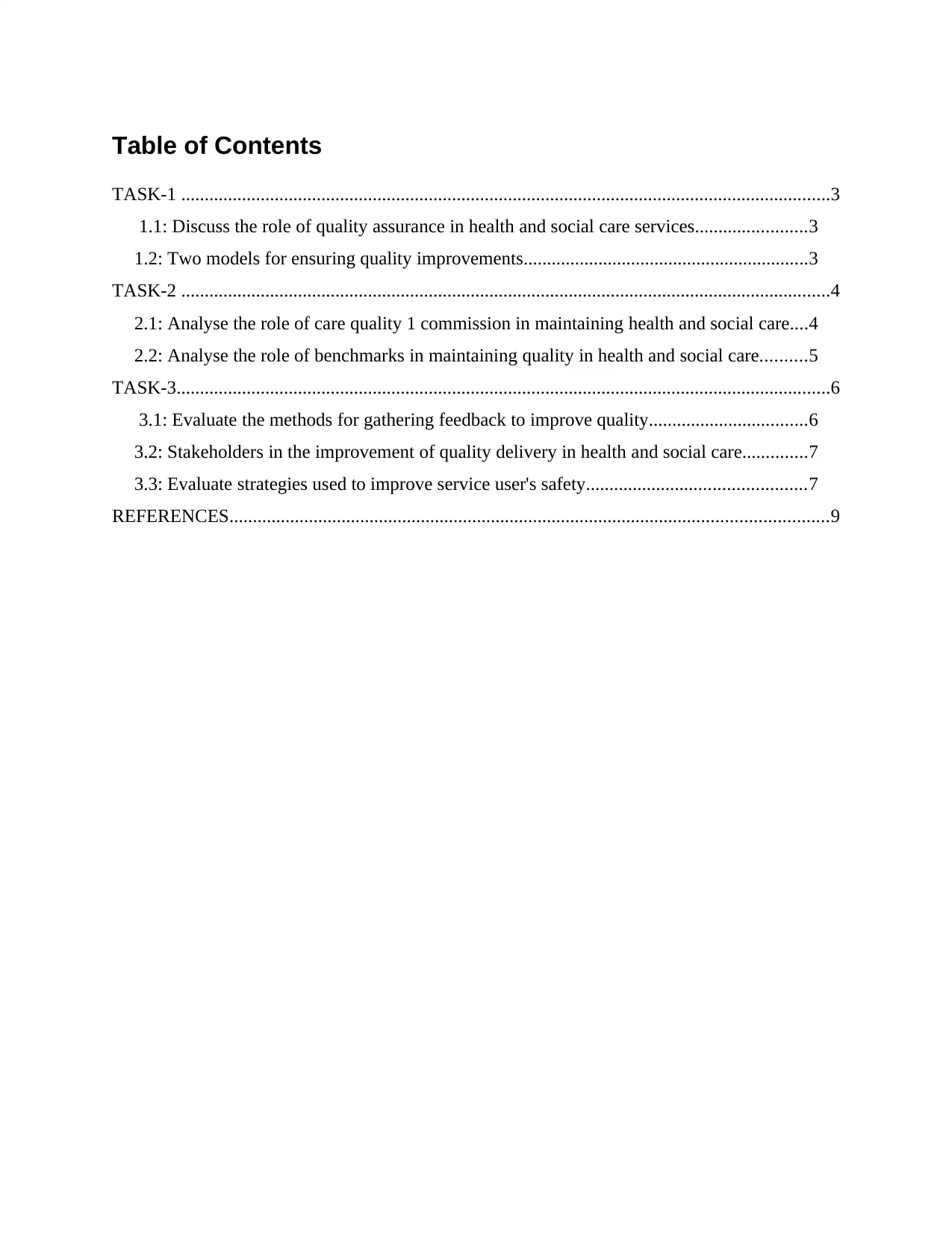
Table of Contents
TASK-1 ...........................................................................................................................................3
1.1: Discuss the role of quality assurance in health and social care services........................3
1.2: Two models for ensuring quality improvements.............................................................3
TASK-2 ...........................................................................................................................................4
2.1: Analyse the role of care quality 1 commission in maintaining health and social care....4
2.2: Analyse the role of benchmarks in maintaining quality in health and social care..........5
TASK-3............................................................................................................................................6
3.1: Evaluate the methods for gathering feedback to improve quality..................................6
3.2: Stakeholders in the improvement of quality delivery in health and social care..............7
3.3: Evaluate strategies used to improve service user's safety...............................................7
REFERENCES................................................................................................................................9
TASK-1 ...........................................................................................................................................3
1.1: Discuss the role of quality assurance in health and social care services........................3
1.2: Two models for ensuring quality improvements.............................................................3
TASK-2 ...........................................................................................................................................4
2.1: Analyse the role of care quality 1 commission in maintaining health and social care....4
2.2: Analyse the role of benchmarks in maintaining quality in health and social care..........5
TASK-3............................................................................................................................................6
3.1: Evaluate the methods for gathering feedback to improve quality..................................6
3.2: Stakeholders in the improvement of quality delivery in health and social care..............7
3.3: Evaluate strategies used to improve service user's safety...............................................7
REFERENCES................................................................................................................................9
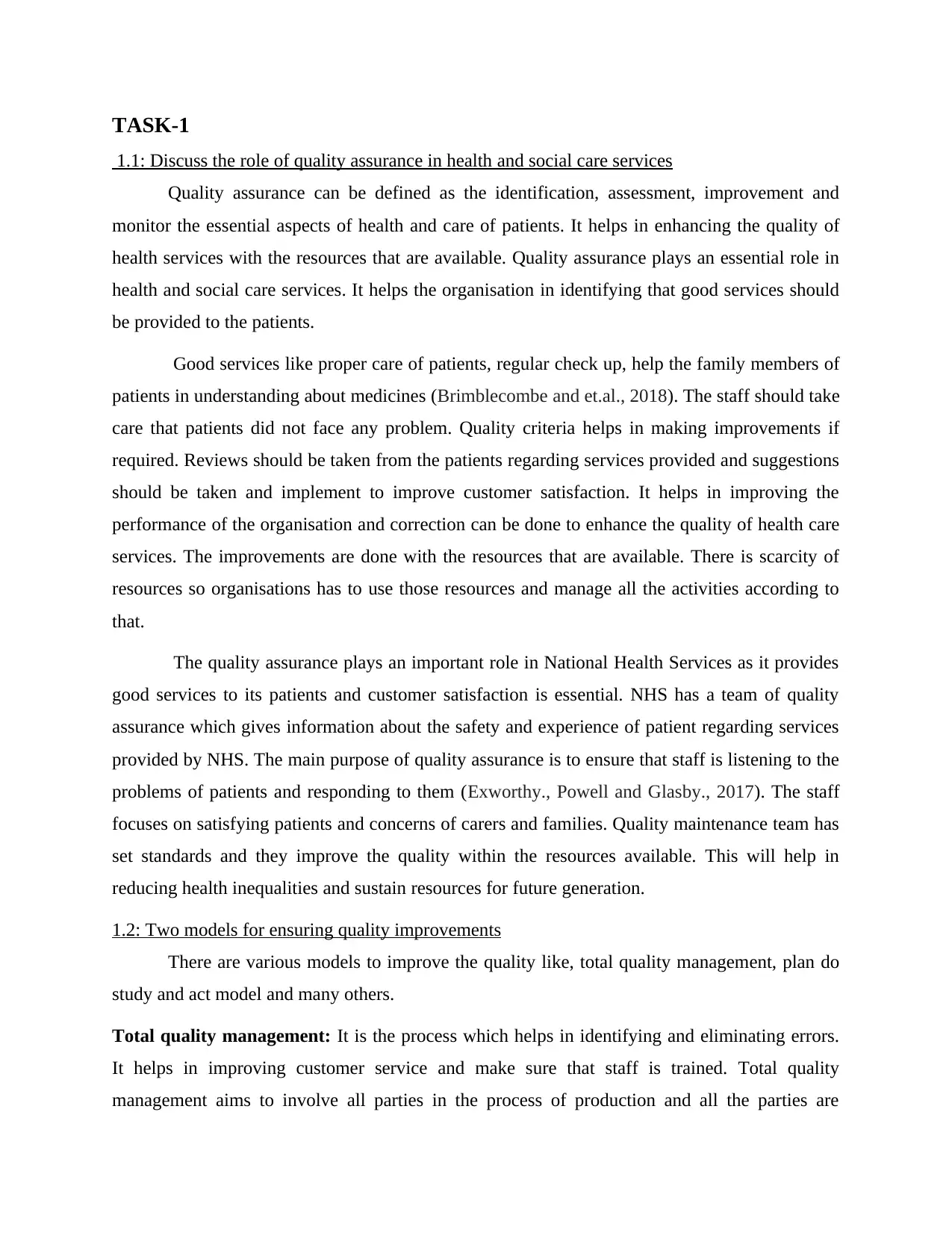
TASK-1
1.1: Discuss the role of quality assurance in health and social care services
Quality assurance can be defined as the identification, assessment, improvement and
monitor the essential aspects of health and care of patients. It helps in enhancing the quality of
health services with the resources that are available. Quality assurance plays an essential role in
health and social care services. It helps the organisation in identifying that good services should
be provided to the patients.
Good services like proper care of patients, regular check up, help the family members of
patients in understanding about medicines (Brimblecombe and et.al., 2018). The staff should take
care that patients did not face any problem. Quality criteria helps in making improvements if
required. Reviews should be taken from the patients regarding services provided and suggestions
should be taken and implement to improve customer satisfaction. It helps in improving the
performance of the organisation and correction can be done to enhance the quality of health care
services. The improvements are done with the resources that are available. There is scarcity of
resources so organisations has to use those resources and manage all the activities according to
that.
The quality assurance plays an important role in National Health Services as it provides
good services to its patients and customer satisfaction is essential. NHS has a team of quality
assurance which gives information about the safety and experience of patient regarding services
provided by NHS. The main purpose of quality assurance is to ensure that staff is listening to the
problems of patients and responding to them (Exworthy., Powell and Glasby., 2017). The staff
focuses on satisfying patients and concerns of carers and families. Quality maintenance team has
set standards and they improve the quality within the resources available. This will help in
reducing health inequalities and sustain resources for future generation.
1.2: Two models for ensuring quality improvements
There are various models to improve the quality like, total quality management, plan do
study and act model and many others.
Total quality management: It is the process which helps in identifying and eliminating errors.
It helps in improving customer service and make sure that staff is trained. Total quality
management aims to involve all parties in the process of production and all the parties are
1.1: Discuss the role of quality assurance in health and social care services
Quality assurance can be defined as the identification, assessment, improvement and
monitor the essential aspects of health and care of patients. It helps in enhancing the quality of
health services with the resources that are available. Quality assurance plays an essential role in
health and social care services. It helps the organisation in identifying that good services should
be provided to the patients.
Good services like proper care of patients, regular check up, help the family members of
patients in understanding about medicines (Brimblecombe and et.al., 2018). The staff should take
care that patients did not face any problem. Quality criteria helps in making improvements if
required. Reviews should be taken from the patients regarding services provided and suggestions
should be taken and implement to improve customer satisfaction. It helps in improving the
performance of the organisation and correction can be done to enhance the quality of health care
services. The improvements are done with the resources that are available. There is scarcity of
resources so organisations has to use those resources and manage all the activities according to
that.
The quality assurance plays an important role in National Health Services as it provides
good services to its patients and customer satisfaction is essential. NHS has a team of quality
assurance which gives information about the safety and experience of patient regarding services
provided by NHS. The main purpose of quality assurance is to ensure that staff is listening to the
problems of patients and responding to them (Exworthy., Powell and Glasby., 2017). The staff
focuses on satisfying patients and concerns of carers and families. Quality maintenance team has
set standards and they improve the quality within the resources available. This will help in
reducing health inequalities and sustain resources for future generation.
1.2: Two models for ensuring quality improvements
There are various models to improve the quality like, total quality management, plan do
study and act model and many others.
Total quality management: It is the process which helps in identifying and eliminating errors.
It helps in improving customer service and make sure that staff is trained. Total quality
management aims to involve all parties in the process of production and all the parties are
⊘ This is a preview!⊘
Do you want full access?
Subscribe today to unlock all pages.

Trusted by 1+ million students worldwide
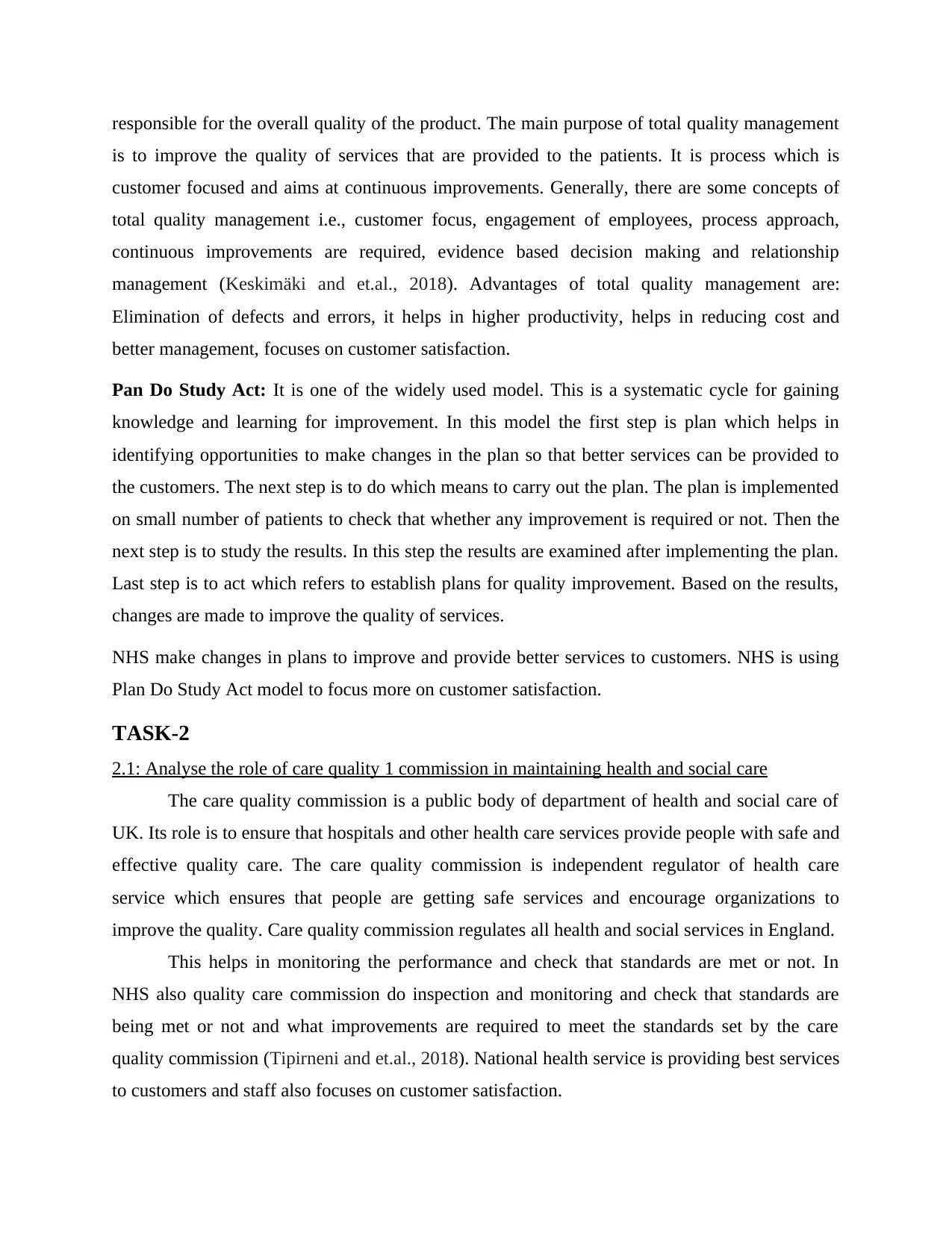
responsible for the overall quality of the product. The main purpose of total quality management
is to improve the quality of services that are provided to the patients. It is process which is
customer focused and aims at continuous improvements. Generally, there are some concepts of
total quality management i.e., customer focus, engagement of employees, process approach,
continuous improvements are required, evidence based decision making and relationship
management (Keskimäki and et.al., 2018). Advantages of total quality management are:
Elimination of defects and errors, it helps in higher productivity, helps in reducing cost and
better management, focuses on customer satisfaction.
Pan Do Study Act: It is one of the widely used model. This is a systematic cycle for gaining
knowledge and learning for improvement. In this model the first step is plan which helps in
identifying opportunities to make changes in the plan so that better services can be provided to
the customers. The next step is to do which means to carry out the plan. The plan is implemented
on small number of patients to check that whether any improvement is required or not. Then the
next step is to study the results. In this step the results are examined after implementing the plan.
Last step is to act which refers to establish plans for quality improvement. Based on the results,
changes are made to improve the quality of services.
NHS make changes in plans to improve and provide better services to customers. NHS is using
Plan Do Study Act model to focus more on customer satisfaction.
TASK-2
2.1: Analyse the role of care quality 1 commission in maintaining health and social care
The care quality commission is a public body of department of health and social care of
UK. Its role is to ensure that hospitals and other health care services provide people with safe and
effective quality care. The care quality commission is independent regulator of health care
service which ensures that people are getting safe services and encourage organizations to
improve the quality. Care quality commission regulates all health and social services in England.
This helps in monitoring the performance and check that standards are met or not. In
NHS also quality care commission do inspection and monitoring and check that standards are
being met or not and what improvements are required to meet the standards set by the care
quality commission (Tipirneni and et.al., 2018). National health service is providing best services
to customers and staff also focuses on customer satisfaction.
is to improve the quality of services that are provided to the patients. It is process which is
customer focused and aims at continuous improvements. Generally, there are some concepts of
total quality management i.e., customer focus, engagement of employees, process approach,
continuous improvements are required, evidence based decision making and relationship
management (Keskimäki and et.al., 2018). Advantages of total quality management are:
Elimination of defects and errors, it helps in higher productivity, helps in reducing cost and
better management, focuses on customer satisfaction.
Pan Do Study Act: It is one of the widely used model. This is a systematic cycle for gaining
knowledge and learning for improvement. In this model the first step is plan which helps in
identifying opportunities to make changes in the plan so that better services can be provided to
the customers. The next step is to do which means to carry out the plan. The plan is implemented
on small number of patients to check that whether any improvement is required or not. Then the
next step is to study the results. In this step the results are examined after implementing the plan.
Last step is to act which refers to establish plans for quality improvement. Based on the results,
changes are made to improve the quality of services.
NHS make changes in plans to improve and provide better services to customers. NHS is using
Plan Do Study Act model to focus more on customer satisfaction.
TASK-2
2.1: Analyse the role of care quality 1 commission in maintaining health and social care
The care quality commission is a public body of department of health and social care of
UK. Its role is to ensure that hospitals and other health care services provide people with safe and
effective quality care. The care quality commission is independent regulator of health care
service which ensures that people are getting safe services and encourage organizations to
improve the quality. Care quality commission regulates all health and social services in England.
This helps in monitoring the performance and check that standards are met or not. In
NHS also quality care commission do inspection and monitoring and check that standards are
being met or not and what improvements are required to meet the standards set by the care
quality commission (Tipirneni and et.al., 2018). National health service is providing best services
to customers and staff also focuses on customer satisfaction.
Paraphrase This Document
Need a fresh take? Get an instant paraphrase of this document with our AI Paraphraser
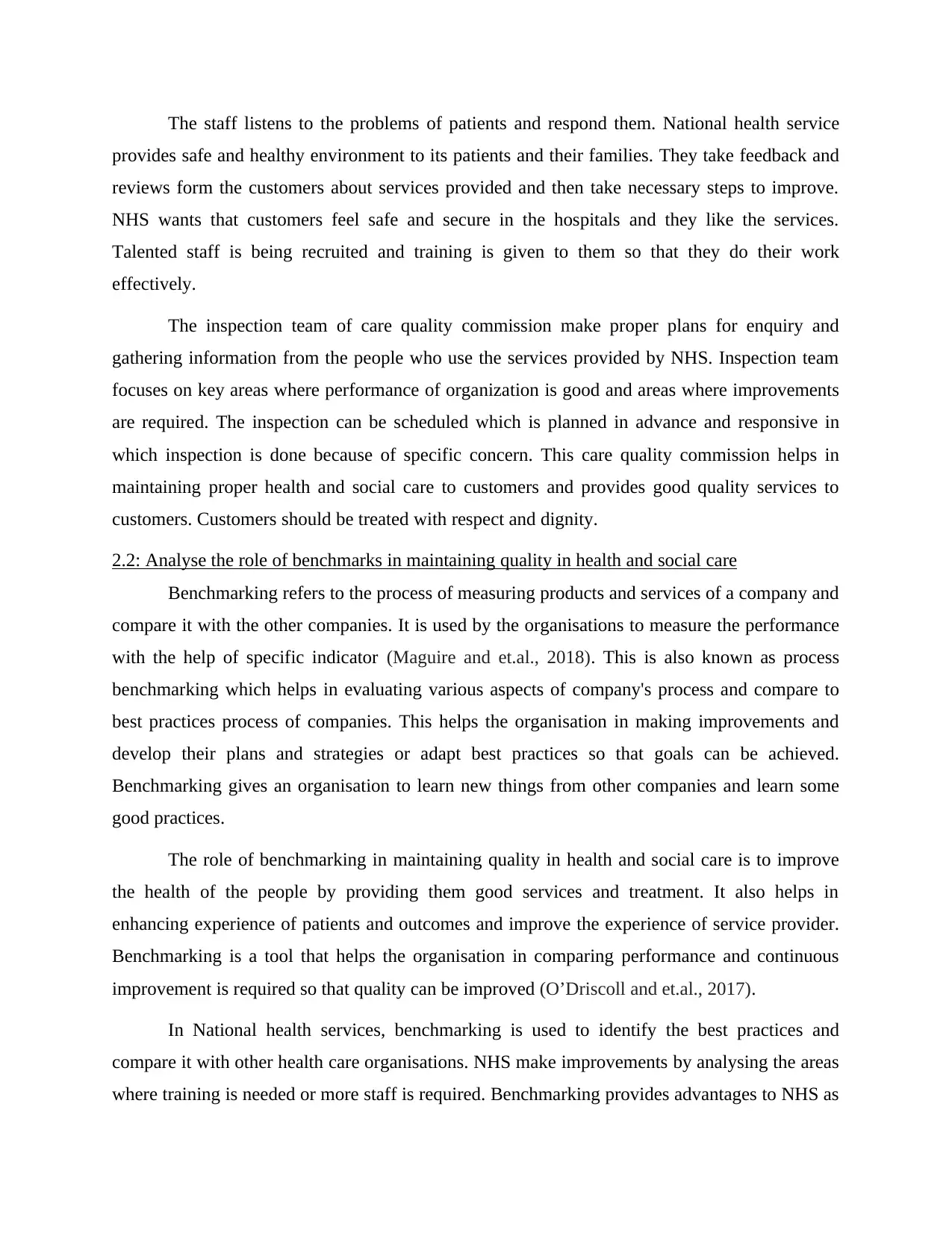
The staff listens to the problems of patients and respond them. National health service
provides safe and healthy environment to its patients and their families. They take feedback and
reviews form the customers about services provided and then take necessary steps to improve.
NHS wants that customers feel safe and secure in the hospitals and they like the services.
Talented staff is being recruited and training is given to them so that they do their work
effectively.
The inspection team of care quality commission make proper plans for enquiry and
gathering information from the people who use the services provided by NHS. Inspection team
focuses on key areas where performance of organization is good and areas where improvements
are required. The inspection can be scheduled which is planned in advance and responsive in
which inspection is done because of specific concern. This care quality commission helps in
maintaining proper health and social care to customers and provides good quality services to
customers. Customers should be treated with respect and dignity.
2.2: Analyse the role of benchmarks in maintaining quality in health and social care
Benchmarking refers to the process of measuring products and services of a company and
compare it with the other companies. It is used by the organisations to measure the performance
with the help of specific indicator (Maguire and et.al., 2018). This is also known as process
benchmarking which helps in evaluating various aspects of company's process and compare to
best practices process of companies. This helps the organisation in making improvements and
develop their plans and strategies or adapt best practices so that goals can be achieved.
Benchmarking gives an organisation to learn new things from other companies and learn some
good practices.
The role of benchmarking in maintaining quality in health and social care is to improve
the health of the people by providing them good services and treatment. It also helps in
enhancing experience of patients and outcomes and improve the experience of service provider.
Benchmarking is a tool that helps the organisation in comparing performance and continuous
improvement is required so that quality can be improved (O’Driscoll and et.al., 2017).
In National health services, benchmarking is used to identify the best practices and
compare it with other health care organisations. NHS make improvements by analysing the areas
where training is needed or more staff is required. Benchmarking provides advantages to NHS as
provides safe and healthy environment to its patients and their families. They take feedback and
reviews form the customers about services provided and then take necessary steps to improve.
NHS wants that customers feel safe and secure in the hospitals and they like the services.
Talented staff is being recruited and training is given to them so that they do their work
effectively.
The inspection team of care quality commission make proper plans for enquiry and
gathering information from the people who use the services provided by NHS. Inspection team
focuses on key areas where performance of organization is good and areas where improvements
are required. The inspection can be scheduled which is planned in advance and responsive in
which inspection is done because of specific concern. This care quality commission helps in
maintaining proper health and social care to customers and provides good quality services to
customers. Customers should be treated with respect and dignity.
2.2: Analyse the role of benchmarks in maintaining quality in health and social care
Benchmarking refers to the process of measuring products and services of a company and
compare it with the other companies. It is used by the organisations to measure the performance
with the help of specific indicator (Maguire and et.al., 2018). This is also known as process
benchmarking which helps in evaluating various aspects of company's process and compare to
best practices process of companies. This helps the organisation in making improvements and
develop their plans and strategies or adapt best practices so that goals can be achieved.
Benchmarking gives an organisation to learn new things from other companies and learn some
good practices.
The role of benchmarking in maintaining quality in health and social care is to improve
the health of the people by providing them good services and treatment. It also helps in
enhancing experience of patients and outcomes and improve the experience of service provider.
Benchmarking is a tool that helps the organisation in comparing performance and continuous
improvement is required so that quality can be improved (O’Driscoll and et.al., 2017).
In National health services, benchmarking is used to identify the best practices and
compare it with other health care organisations. NHS make improvements by analysing the areas
where training is needed or more staff is required. Benchmarking provides advantages to NHS as
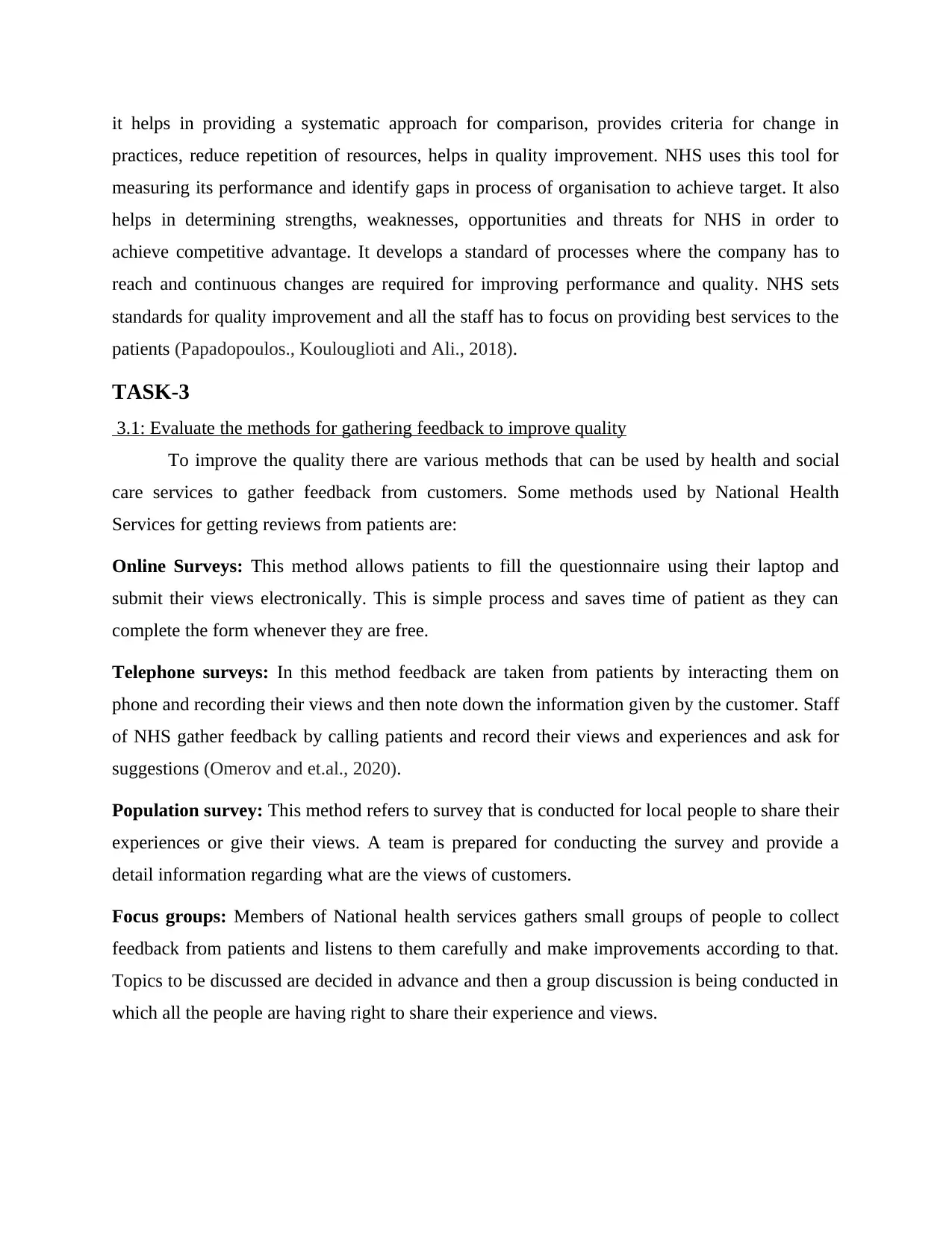
it helps in providing a systematic approach for comparison, provides criteria for change in
practices, reduce repetition of resources, helps in quality improvement. NHS uses this tool for
measuring its performance and identify gaps in process of organisation to achieve target. It also
helps in determining strengths, weaknesses, opportunities and threats for NHS in order to
achieve competitive advantage. It develops a standard of processes where the company has to
reach and continuous changes are required for improving performance and quality. NHS sets
standards for quality improvement and all the staff has to focus on providing best services to the
patients (Papadopoulos., Koulouglioti and Ali., 2018).
TASK-3
3.1: Evaluate the methods for gathering feedback to improve quality
To improve the quality there are various methods that can be used by health and social
care services to gather feedback from customers. Some methods used by National Health
Services for getting reviews from patients are:
Online Surveys: This method allows patients to fill the questionnaire using their laptop and
submit their views electronically. This is simple process and saves time of patient as they can
complete the form whenever they are free.
Telephone surveys: In this method feedback are taken from patients by interacting them on
phone and recording their views and then note down the information given by the customer. Staff
of NHS gather feedback by calling patients and record their views and experiences and ask for
suggestions (Omerov and et.al., 2020).
Population survey: This method refers to survey that is conducted for local people to share their
experiences or give their views. A team is prepared for conducting the survey and provide a
detail information regarding what are the views of customers.
Focus groups: Members of National health services gathers small groups of people to collect
feedback from patients and listens to them carefully and make improvements according to that.
Topics to be discussed are decided in advance and then a group discussion is being conducted in
which all the people are having right to share their experience and views.
practices, reduce repetition of resources, helps in quality improvement. NHS uses this tool for
measuring its performance and identify gaps in process of organisation to achieve target. It also
helps in determining strengths, weaknesses, opportunities and threats for NHS in order to
achieve competitive advantage. It develops a standard of processes where the company has to
reach and continuous changes are required for improving performance and quality. NHS sets
standards for quality improvement and all the staff has to focus on providing best services to the
patients (Papadopoulos., Koulouglioti and Ali., 2018).
TASK-3
3.1: Evaluate the methods for gathering feedback to improve quality
To improve the quality there are various methods that can be used by health and social
care services to gather feedback from customers. Some methods used by National Health
Services for getting reviews from patients are:
Online Surveys: This method allows patients to fill the questionnaire using their laptop and
submit their views electronically. This is simple process and saves time of patient as they can
complete the form whenever they are free.
Telephone surveys: In this method feedback are taken from patients by interacting them on
phone and recording their views and then note down the information given by the customer. Staff
of NHS gather feedback by calling patients and record their views and experiences and ask for
suggestions (Omerov and et.al., 2020).
Population survey: This method refers to survey that is conducted for local people to share their
experiences or give their views. A team is prepared for conducting the survey and provide a
detail information regarding what are the views of customers.
Focus groups: Members of National health services gathers small groups of people to collect
feedback from patients and listens to them carefully and make improvements according to that.
Topics to be discussed are decided in advance and then a group discussion is being conducted in
which all the people are having right to share their experience and views.
⊘ This is a preview!⊘
Do you want full access?
Subscribe today to unlock all pages.

Trusted by 1+ million students worldwide
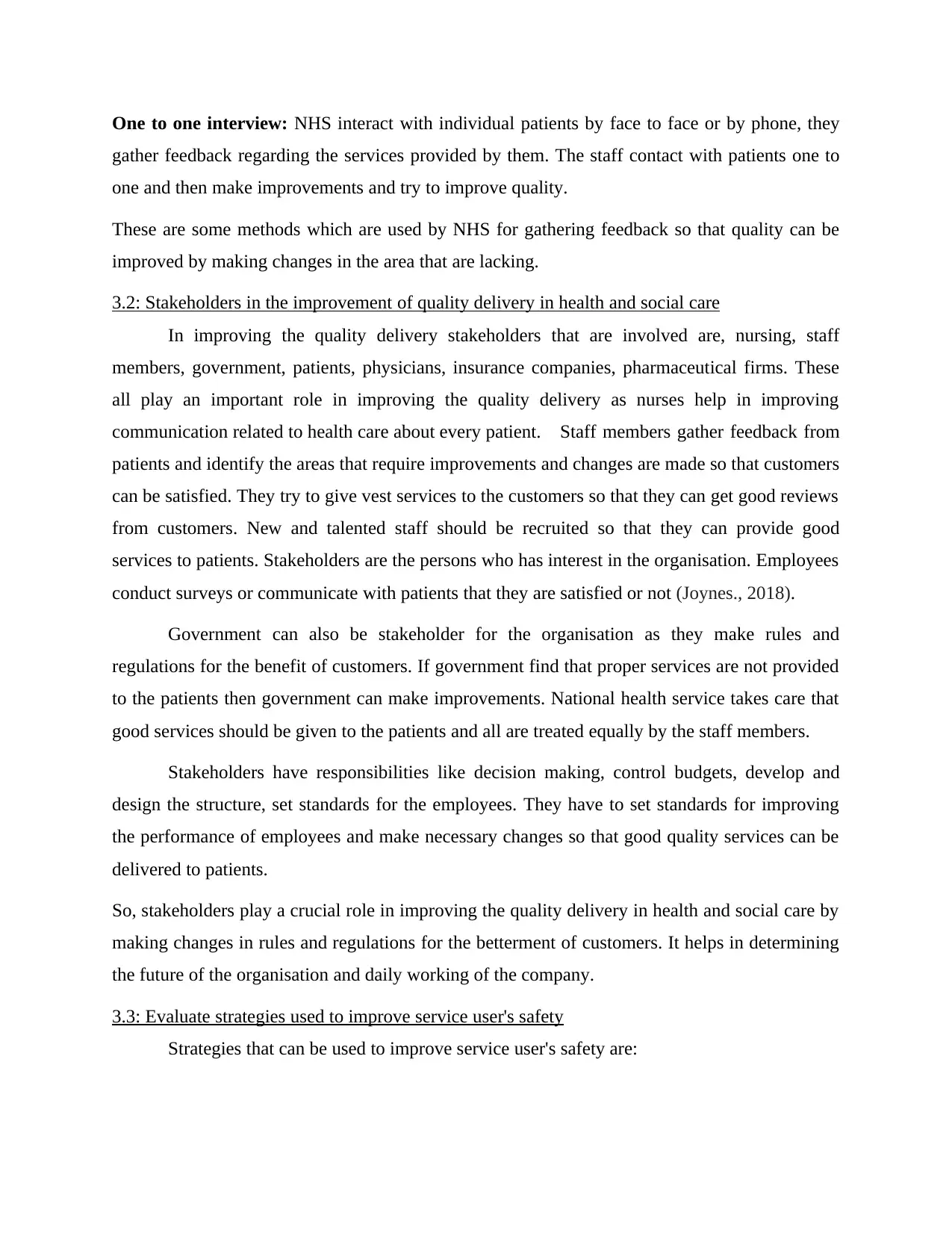
One to one interview: NHS interact with individual patients by face to face or by phone, they
gather feedback regarding the services provided by them. The staff contact with patients one to
one and then make improvements and try to improve quality.
These are some methods which are used by NHS for gathering feedback so that quality can be
improved by making changes in the area that are lacking.
3.2: Stakeholders in the improvement of quality delivery in health and social care
In improving the quality delivery stakeholders that are involved are, nursing, staff
members, government, patients, physicians, insurance companies, pharmaceutical firms. These
all play an important role in improving the quality delivery as nurses help in improving
communication related to health care about every patient. Staff members gather feedback from
patients and identify the areas that require improvements and changes are made so that customers
can be satisfied. They try to give vest services to the customers so that they can get good reviews
from customers. New and talented staff should be recruited so that they can provide good
services to patients. Stakeholders are the persons who has interest in the organisation. Employees
conduct surveys or communicate with patients that they are satisfied or not (Joynes., 2018).
Government can also be stakeholder for the organisation as they make rules and
regulations for the benefit of customers. If government find that proper services are not provided
to the patients then government can make improvements. National health service takes care that
good services should be given to the patients and all are treated equally by the staff members.
Stakeholders have responsibilities like decision making, control budgets, develop and
design the structure, set standards for the employees. They have to set standards for improving
the performance of employees and make necessary changes so that good quality services can be
delivered to patients.
So, stakeholders play a crucial role in improving the quality delivery in health and social care by
making changes in rules and regulations for the betterment of customers. It helps in determining
the future of the organisation and daily working of the company.
3.3: Evaluate strategies used to improve service user's safety
Strategies that can be used to improve service user's safety are:
gather feedback regarding the services provided by them. The staff contact with patients one to
one and then make improvements and try to improve quality.
These are some methods which are used by NHS for gathering feedback so that quality can be
improved by making changes in the area that are lacking.
3.2: Stakeholders in the improvement of quality delivery in health and social care
In improving the quality delivery stakeholders that are involved are, nursing, staff
members, government, patients, physicians, insurance companies, pharmaceutical firms. These
all play an important role in improving the quality delivery as nurses help in improving
communication related to health care about every patient. Staff members gather feedback from
patients and identify the areas that require improvements and changes are made so that customers
can be satisfied. They try to give vest services to the customers so that they can get good reviews
from customers. New and talented staff should be recruited so that they can provide good
services to patients. Stakeholders are the persons who has interest in the organisation. Employees
conduct surveys or communicate with patients that they are satisfied or not (Joynes., 2018).
Government can also be stakeholder for the organisation as they make rules and
regulations for the benefit of customers. If government find that proper services are not provided
to the patients then government can make improvements. National health service takes care that
good services should be given to the patients and all are treated equally by the staff members.
Stakeholders have responsibilities like decision making, control budgets, develop and
design the structure, set standards for the employees. They have to set standards for improving
the performance of employees and make necessary changes so that good quality services can be
delivered to patients.
So, stakeholders play a crucial role in improving the quality delivery in health and social care by
making changes in rules and regulations for the betterment of customers. It helps in determining
the future of the organisation and daily working of the company.
3.3: Evaluate strategies used to improve service user's safety
Strategies that can be used to improve service user's safety are:
Paraphrase This Document
Need a fresh take? Get an instant paraphrase of this document with our AI Paraphraser
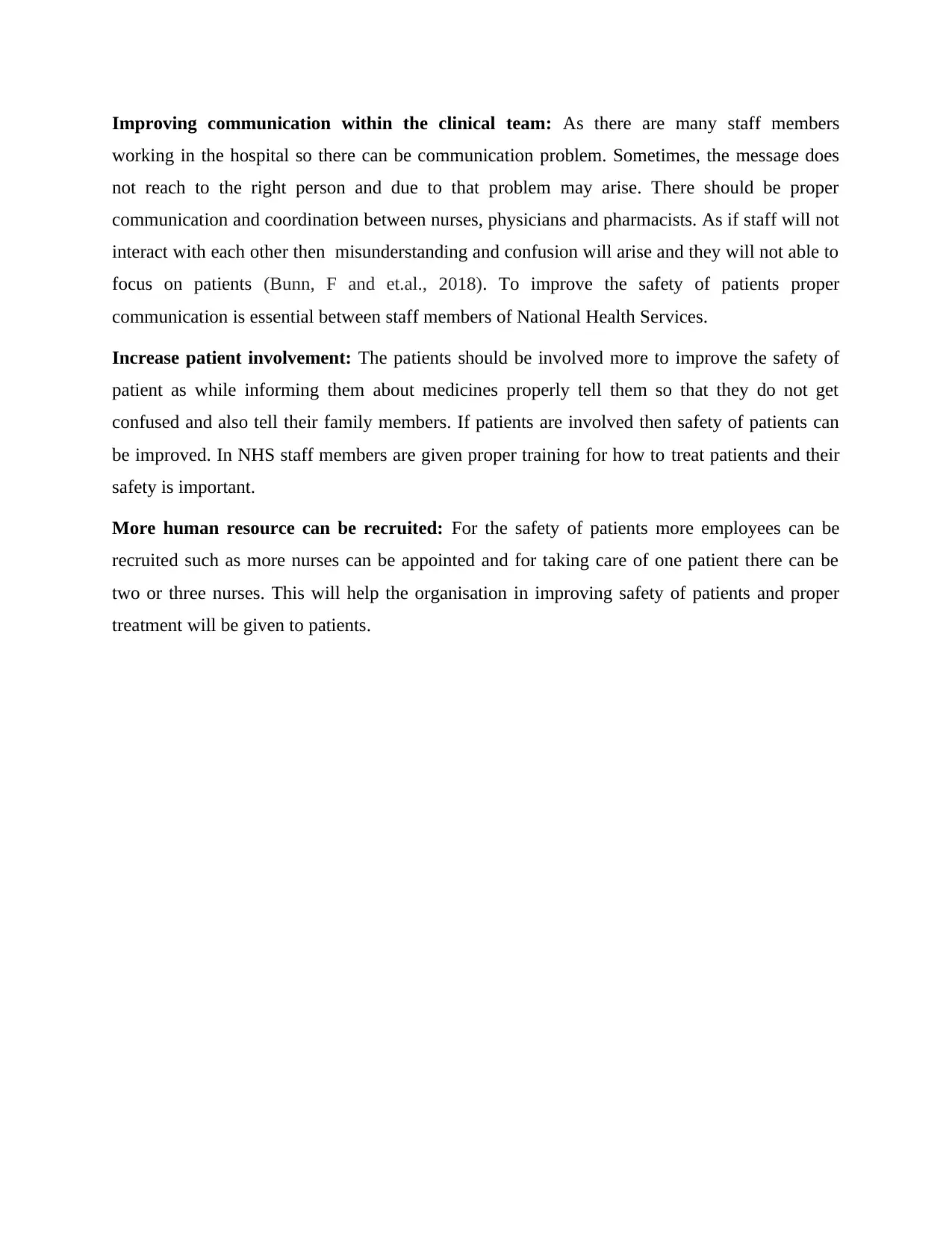
Improving communication within the clinical team: As there are many staff members
working in the hospital so there can be communication problem. Sometimes, the message does
not reach to the right person and due to that problem may arise. There should be proper
communication and coordination between nurses, physicians and pharmacists. As if staff will not
interact with each other then misunderstanding and confusion will arise and they will not able to
focus on patients (Bunn, F and et.al., 2018). To improve the safety of patients proper
communication is essential between staff members of National Health Services.
Increase patient involvement: The patients should be involved more to improve the safety of
patient as while informing them about medicines properly tell them so that they do not get
confused and also tell their family members. If patients are involved then safety of patients can
be improved. In NHS staff members are given proper training for how to treat patients and their
safety is important.
More human resource can be recruited: For the safety of patients more employees can be
recruited such as more nurses can be appointed and for taking care of one patient there can be
two or three nurses. This will help the organisation in improving safety of patients and proper
treatment will be given to patients.
working in the hospital so there can be communication problem. Sometimes, the message does
not reach to the right person and due to that problem may arise. There should be proper
communication and coordination between nurses, physicians and pharmacists. As if staff will not
interact with each other then misunderstanding and confusion will arise and they will not able to
focus on patients (Bunn, F and et.al., 2018). To improve the safety of patients proper
communication is essential between staff members of National Health Services.
Increase patient involvement: The patients should be involved more to improve the safety of
patient as while informing them about medicines properly tell them so that they do not get
confused and also tell their family members. If patients are involved then safety of patients can
be improved. In NHS staff members are given proper training for how to treat patients and their
safety is important.
More human resource can be recruited: For the safety of patients more employees can be
recruited such as more nurses can be appointed and for taking care of one patient there can be
two or three nurses. This will help the organisation in improving safety of patients and proper
treatment will be given to patients.
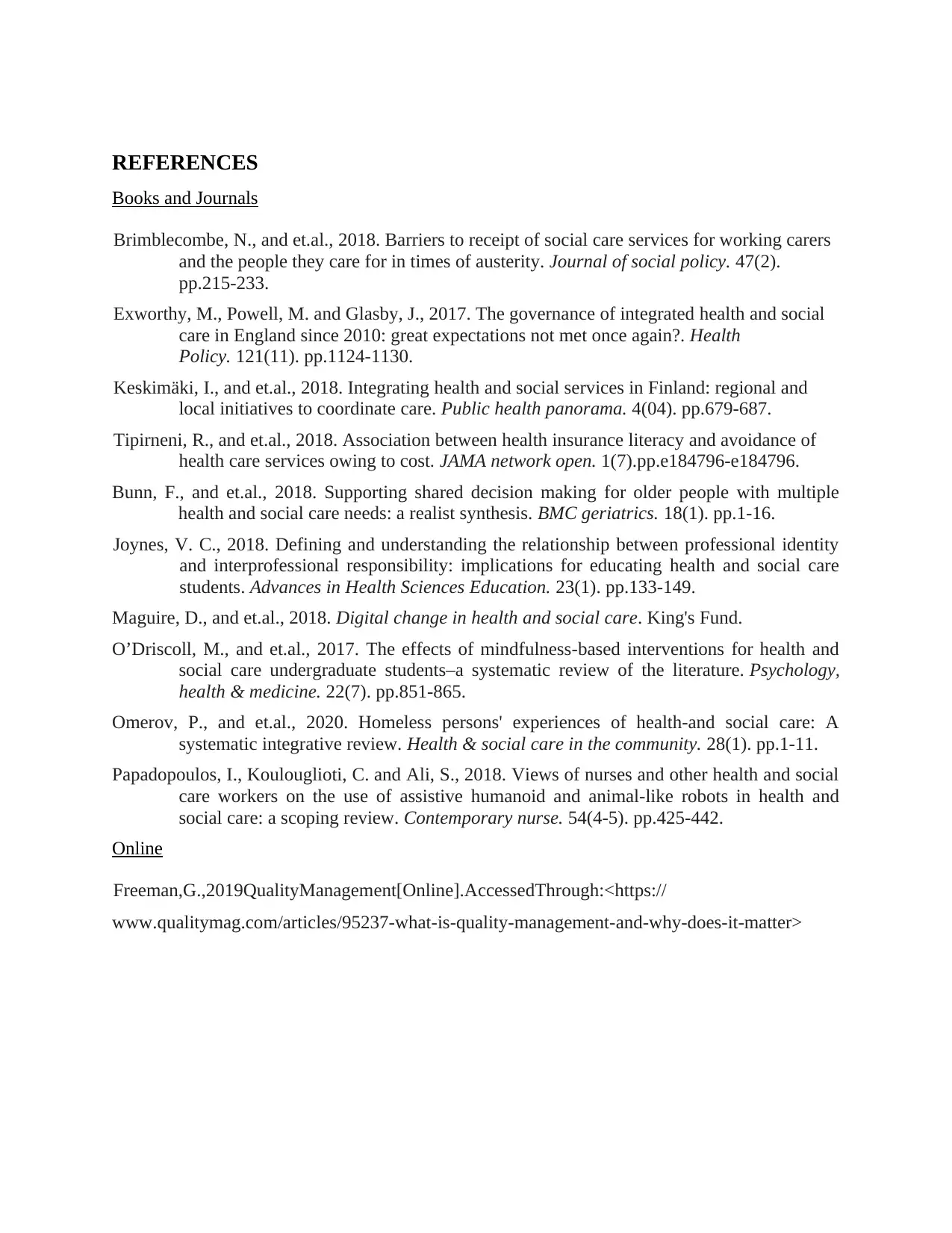
REFERENCES
Books and Journals
Brimblecombe, N., and et.al., 2018. Barriers to receipt of social care services for working carers
and the people they care for in times of austerity. Journal of social policy. 47(2).
pp.215-233.
Exworthy, M., Powell, M. and Glasby, J., 2017. The governance of integrated health and social
care in England since 2010: great expectations not met once again?. Health
Policy. 121(11). pp.1124-1130.
Keskimäki, I., and et.al., 2018. Integrating health and social services in Finland: regional and
local initiatives to coordinate care. Public health panorama. 4(04). pp.679-687.
Tipirneni, R., and et.al., 2018. Association between health insurance literacy and avoidance of
health care services owing to cost. JAMA network open. 1(7).pp.e184796-e184796.
Bunn, F., and et.al., 2018. Supporting shared decision making for older people with multiple
health and social care needs: a realist synthesis. BMC geriatrics. 18(1). pp.1-16.
Joynes, V. C., 2018. Defining and understanding the relationship between professional identity
and interprofessional responsibility: implications for educating health and social care
students. Advances in Health Sciences Education. 23(1). pp.133-149.
Maguire, D., and et.al., 2018. Digital change in health and social care. King's Fund.
O’Driscoll, M., and et.al., 2017. The effects of mindfulness-based interventions for health and
social care undergraduate students–a systematic review of the literature. Psychology,
health & medicine. 22(7). pp.851-865.
Omerov, P., and et.al., 2020. Homeless persons' experiences of health‐and social care: A
systematic integrative review. Health & social care in the community. 28(1). pp.1-11.
Papadopoulos, I., Koulouglioti, C. and Ali, S., 2018. Views of nurses and other health and social
care workers on the use of assistive humanoid and animal-like robots in health and
social care: a scoping review. Contemporary nurse. 54(4-5). pp.425-442.
Online
Freeman,G.,2019QualityManagement[Online].AccessedThrough:<https://
www.qualitymag.com/articles/95237-what-is-quality-management-and-why-does-it-matter>
Books and Journals
Brimblecombe, N., and et.al., 2018. Barriers to receipt of social care services for working carers
and the people they care for in times of austerity. Journal of social policy. 47(2).
pp.215-233.
Exworthy, M., Powell, M. and Glasby, J., 2017. The governance of integrated health and social
care in England since 2010: great expectations not met once again?. Health
Policy. 121(11). pp.1124-1130.
Keskimäki, I., and et.al., 2018. Integrating health and social services in Finland: regional and
local initiatives to coordinate care. Public health panorama. 4(04). pp.679-687.
Tipirneni, R., and et.al., 2018. Association between health insurance literacy and avoidance of
health care services owing to cost. JAMA network open. 1(7).pp.e184796-e184796.
Bunn, F., and et.al., 2018. Supporting shared decision making for older people with multiple
health and social care needs: a realist synthesis. BMC geriatrics. 18(1). pp.1-16.
Joynes, V. C., 2018. Defining and understanding the relationship between professional identity
and interprofessional responsibility: implications for educating health and social care
students. Advances in Health Sciences Education. 23(1). pp.133-149.
Maguire, D., and et.al., 2018. Digital change in health and social care. King's Fund.
O’Driscoll, M., and et.al., 2017. The effects of mindfulness-based interventions for health and
social care undergraduate students–a systematic review of the literature. Psychology,
health & medicine. 22(7). pp.851-865.
Omerov, P., and et.al., 2020. Homeless persons' experiences of health‐and social care: A
systematic integrative review. Health & social care in the community. 28(1). pp.1-11.
Papadopoulos, I., Koulouglioti, C. and Ali, S., 2018. Views of nurses and other health and social
care workers on the use of assistive humanoid and animal-like robots in health and
social care: a scoping review. Contemporary nurse. 54(4-5). pp.425-442.
Online
Freeman,G.,2019QualityManagement[Online].AccessedThrough:<https://
www.qualitymag.com/articles/95237-what-is-quality-management-and-why-does-it-matter>
⊘ This is a preview!⊘
Do you want full access?
Subscribe today to unlock all pages.

Trusted by 1+ million students worldwide
1 out of 9
Related Documents
Your All-in-One AI-Powered Toolkit for Academic Success.
+13062052269
info@desklib.com
Available 24*7 on WhatsApp / Email
![[object Object]](/_next/static/media/star-bottom.7253800d.svg)
Unlock your academic potential
Copyright © 2020–2025 A2Z Services. All Rights Reserved. Developed and managed by ZUCOL.




